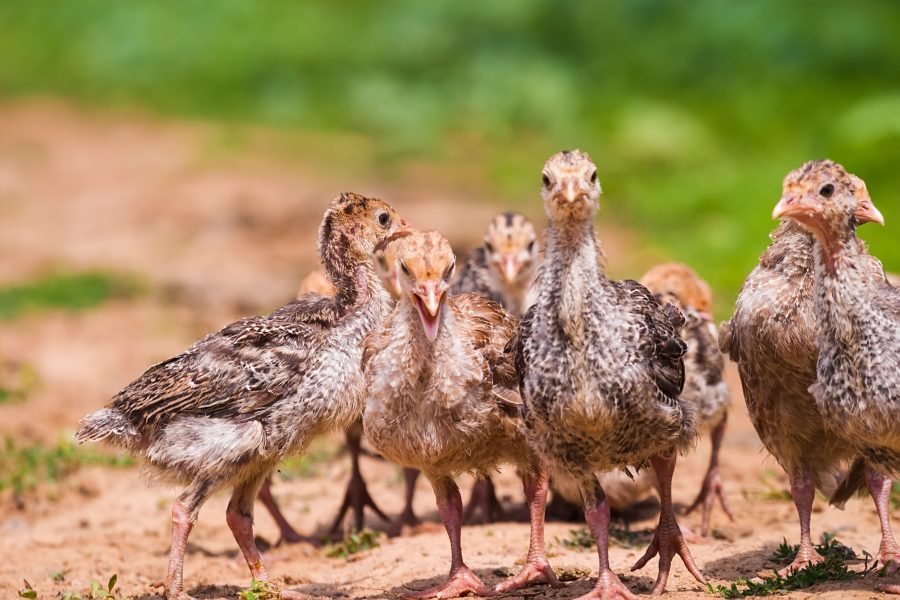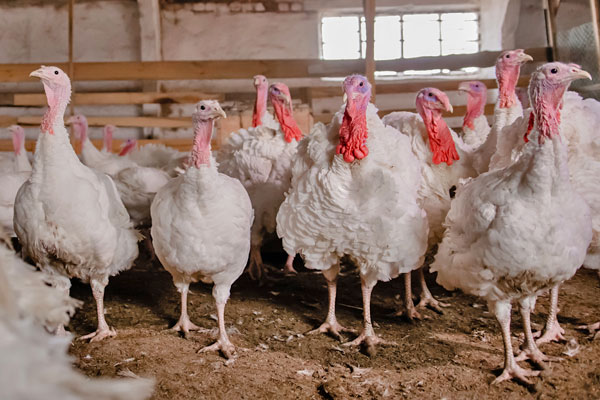In my experience, learning how to take care of turkey poults (baby turkeys) is similar to raising baby chickens, so if you’ve owned chickens for any length of time, you’re off to a great start, but, either way, I’ll walk you through the basics.
Buying free-range, organic turkey meat is expensive, so learning how to take care of turkey poults has reduced my meat budget while also being a fairly simple and enjoyable experience. I highly recommend following these simple steps to raise a healthy turkey flock of your own.
Raising turkey poults and wondering when it’s safe to move them outdoors? Knowing the right time to transition poults from the brooder to outdoor housing is key to keeping them healthy and thriving. Move them too soon and they may get chilled, stressed, or fall prey to predators. Wait too long and they may get overheated and crowded in the brooder. So when is the optimal time?
Assessing Feather Cover and Temperature
The two most important factors determining poult readiness for the outdoors are their feather development and the ambient temperature,
Wait Until Fully Feathered
Poults need to be fully feathered before going outside. Their fluffy baby down provides warmth in the brooder but not enough protection from wind rain, and cold when outdoors.
Feathers develop rapidly in poults You’ll notice feathers emerging on their wings around 2-3 weeks. Check under the wing around 4 weeks – the area should be completely filled in Primary feathers on the wings will be nearly full length by 6 weeks. The belly will fill in more slowly than the back and wings. Run your hands gently over the breast and leg areas before moving them out. Any large bare patches mean they need more time in the brooder.
Match Brooder and Outdoor Temps
Outdoor temperature must be close to what poults are accustomed to in the brooder. Abrupt temperature drops are very stressful. Each week in the brooder, lower the temperature by 5°F to help them acclimate. By 6-7 weeks when fully feathered, their temperature needs will match outdoor conditions in most climates.
If outdoor temps are much cooler than the brooder, postpone move. Monitor forecasts too – a heat wave or cold snap means adjusting plans.
Ideally, target the move for a stretch of mild, consistent weather. In extreme heat or cold, they may need to stay in the brooder for another 1-2 weeks until conditions improve.
6-7 Weeks – The Typical Target Age
With proper brooding temps and feed, poults are normally ready to live outdoors at 6-7 weeks old, once fully feathered.
Heritage breeds may feather a bit slower than commercial poults. Large turkey breeds like Narragansett may also need a week or two longer than smaller Bronze or White poults. But for most poults by 6-7 weeks, the combination of feather cover and hardiness makes outdoor life possible.
If poults seem crowded, restless, or overheated in the brooder near this age, it’s a sign they need more space. Assuming the weather forecast looks safe, go ahead and move them to their outdoor pen.
Indicators Poults Are Ready
Besides age, here are signs your poults are ready for the big move:
- Fully feathered with minimal bare patches
- No longer huddling near brooder heat source
- Moving freely around brooder, not just staying put near heat
- Appearing crowded or agitated in brooder
- Brooder temperature close to current outdoor temps
- Weather forecast showing a stretch of mild days/nights
If you see most of these indicators, your poults will likely handle the outdoor transition well.
Setting Up a Safe Outdoor Space
When moving poults outside, they need an enclosed, predator-proof pen with shelter, food, and water. Think of this as an “outside brooder” keeping them safe while allowing more space. Some key elements:
Sturdy Fencing
Use 1-inch wire mesh fencing or similar to enclose the pen. Bury the bottom edge to prevent diggers. Make sure openings are too small for poults to squeeze through. Height should be at least 4-5 feet for flightless poults, or 6-8 feet for heritage breeds that can fly.
Shelter from Elements
Provide a draft-free shelter, like a small coop or shed. Make sure it’s large enough for all poults to enter and has adequate ventilation. Bed the floor with pine shavings or other litter. They’ll need the shelter at night and during wet, windy, or extremely hot or cold weather.
Protection from Predators
Secure outdoor pens to keep predators like dogs, coyotes, foxes, raccoons, and hawks out. Bury fencing, use aviary netting over the top, and keep the shelter door shut at night. Check for openings or gaps regularly and repair any you find.
Plentiful Feed and Water
Supply feed and water round the clock. Use sturdy containers that poults can’t tip over or contaminate. Refresh water at least twice daily. Feeders and waters should be set under or near the shelter to keep contents clean and dry.
Monitor Conditions
Check on poults multiple times a day once moved outdoors. Make sure they are utilizing the shelter and appear comfy in the temperature conditions. Look for signs of distress like huddling, panting, or noisy breathing. Be prepared to return them to the brooder if they seem stressed or unwell after the move.
With attentive brooding followed by a well-planned transition to outdoor living, your poults will continue thriving as they grow. Taking these steps will help ensure your poults stay healthy and develop into hardy, vigorous turkeys. Wishing you success in raising your flock!

Why You Might Consider Raising Turkey Poults, AKA Turkey Chicks

You might consider taking care of turkey poults and raising them into grass-fed, healthy adult turkeys for numerous reasons. A poult is simply a baby turkey, and these funny little creatures can grow into a lean protein that’s great for tasty holiday meals, winter soups, and summer sandwiches.
Reasons To Raise Turkey Poults
- They are gentle, intelligent birds.
- They provide delicious organic meat.
- They are cleaner birds than chickens.
- Their eggs make a healthy, occasional treat (though you’ll probably want to save most for hatching new birds).

How Long Does It Take To Raise A Baby Turkey?
It takes about eight weeks to raise a baby turkey indoors before they are ready for outside life. They’ll spend the first few weeks in their heated brooder before you’ll gradually start to lower the temperature and maybe even bring their brooder onto your porch sometimes to acclimate them to outdoor weather little by little.
Between six and eight weeks is when I usually move my poults outside, depending on when their feathers finish coming in. The turkeys will mature between 14 and 22 weeks of age (depending on the breed), though heritage breeds take between 25 and 30 weeks to mature.
Moving Our First Ever Turkeys Outside
FAQ
When can I move my baby turkey outside?
How long do baby turkeys need a heat lamp?
What temperature can baby turkeys tolerate?
How old do turkeys have to be to go outside?
When do turkey poults go outside?
Your turkey poults can go outside when they are 6-7 weeks old and fully feathered. The “fully feathered” part is the key here. If you still see the fluffy baby feathers, your poults still need the brooder. The outside temperature must be close to the temperature of the brooder that the poults just came out of.
When do baby turkeys go outside?
Between six and eight weeks is when I usually move my poults outside, depending on when their feathers finish coming in. The turkeys will mature between 14 and 22 weeks of age (depending on the breed), though heritage breeds take between 25 and 30 weeks to mature. How Soon Can Baby Turkeys Go Outside?
How long do turkey poults stay in a brooder?
Keep the spacing at 2.5 sq. ft. each for as long as the poults are in the brooder. Your poults will need to stay in a brooder until they are fully feathered, which will take anywhere from 6-8 weeks. Don’t rush this part. Turkeys do not recover well from set backs, and taking away their heat before they are ready can cause problems.
How do I care for my turkey poults?
For the turkey poults’ comfort, it’s important to select the right brooder bedding, and I recommend using large flake wood shavings to cover the bottom of your turkey brooders for the first few weeks of your poults’ lives.
